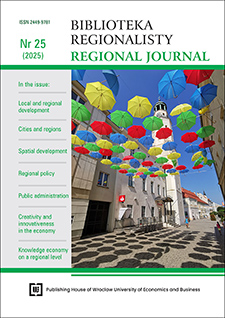Wpływ depopulacji gmin województwa świętokrzyskiegona zmiany zielonej infrastruktury
DOI:
https://doi.org/10.15611/br.2025.1.04Słowa kluczowe:
zielona infrastruktura, demografia, miara syntetyczna, metoda CRITIC-TOPSISAbstrakt
Tło: Depopulacja prowadzi do zmian w obszarze terenów zielonych i jakości życia, ale może również stwarzać szanse na rewitalizację przestrzeni. Zielona infrastruktura jest kluczowa dla zrównoważonego rozwoju, zdrowia publicznego i adaptacji do zmian klimatycznych.
Cel: Celem jest ocena i identyfikacja wyzwań związanych z wyludnianiem gmin województwa świętokrzyskiego oraz ocena możliwości rewitalizacji terenów zielonych przy ograniczonych zasobach. Badanie koncentruje się na tym, jak depopulacja wpływa na jakość zielonej infrastruktury.
Metodyka: W badaniach zastosowano analizę literatury, metody statystyczne oraz TOPSIS, zbierając dane empiryczne z gmin województwa świętokrzyskiego w latach 2014 i 2022, co pozwoliło uchwycić dynamikę zjawisk i monitorować zmiany koniunkturalne.
Wyniki: Badanie wpływu depopulacji na zieloną infrastrukturę w gminach województwa świętokrzyskiego wskazało na pozytywne zmiany w jakości terenów zielonych, sprzyjające zrównoważonemu rozwojowi, rewitalizacji przestrzeni miejskich oraz tworzeniu nowych przestrzeni zielonych w odpowiedzi na zmiany demograficzne.
Implikacje i rekomendacje: Zaleca się kontynuowanie inwestycji w zieloną infrastrukturę, szczególnie w obszarach o jej mniejszej koncentracji, oraz monitorowanie zmian w rozmieszczeniu terenów zielonych i demografii.
Oryginalność/wartość: Badanie analizuje zależności między strukturą demograficzną a zieloną infrastrukturą w gminach, wykorzystując miarę syntetyczną dla obu obszarów w celu porównania lat 2014 i 2022, co pozwala ocenić ich wpływ na środowisko naturalne, proces depopulacji, infrastrukturę.
Pobrania
Bibliografia
Acevedo, S., & José, C. (2019). Multi-Response Optimization of Porous Asphalt Mixtures Reinforced with Aramid and Polyolefin Fibers Employing the CRITIC-TOPSIS Based on Taguchi Methodology. Materials, 12, 3789.
Anselin, L. (1995). Local Indicators of Spatial Association – LISA. Geographical Analysis, 27(2), 93-115.
de Manuel, B. F., Méndez-Fernández, L., Peña, L., & Ametzaga-Arregi, I. (2021). A New Indicator of the Effectiveness of Urban Green Infrastructure Based on Ecosystem Services Assessment. Basic and Applied Ecology, 53, 12-25. https://doi.org/10.1016/j.baae.2021.02.012
Du, X., Wang, Y., & Chen, F. (2024). Evaluation of Coal-Resource-Based Cities Transformation Based on CRITIC-TOPSIS Model. Sustainable Cities and Society, 103, 105271. https://doi.org/10.1016/j.scs.2024.105271
Gebreyesus, T., Borgemeister, Ch., Herrero-Jáuregui, C., & Kelboro, G. (2024). Transforming Urban Air Quality: Green Infrastructure Strategies for the Urban Centers of Ethiopia. Environmental Pollution, 363, Part 2, 125244. https://doi.org/10.1016/j.envpol.2024.125244
Karanikola, P., Panagopoulos, T., Tampakis, S., Simoglou, G., & Tzelepi, A. (2023). Perceptions of Urban Green Infrastructure in Two Contrasting Municipalities of the Metropolitan Area of Athens, Greece. Nature-Based Solutions, 3, 100063. https://doi.org/10.1016/j.nbsj.2023.100063
Kaveh, S., Habibi, A., Nikkar, M., & Aflaki, A. (2024). Optimizing Green Infrastructure Strategies for Microclimate Regulation and Air Quality Improvement in Urban Environments: A Case Study. Nature-Based Solutions, 6, 100167. https://doi.org/10.1016/j.nbsj.2024.100167
Kuo, T. (2017). A Modified TOPSIS with a Different Ranking Index. European Journal of Operational Research, 260(1), 152-160. https://doi.org/10.1016/j.ejor.2016.11.052
Lin, T., Cai, J., Geng, H., Zheng, Y., Zeng, Z., & Zheng, Y. (2024). Incorporating Suburban Cropland into Urban Green Infrastructure: A Perspective of Nature-Based Solutions in China. Nature-Based Solutions, 5, 100122. https://doi.org/10.1016/j.nbsj.2024.100122
Longley, P., Goodchild, M. F., Maguire, D. J., & Rhind, D. W. (2006). GIS. Teoria i praktyka. Wyd. Naukowe PWN.
Marques, A. L., & Tanus Benatti Alvim, A. (2024). Metropolitan Fringes as Strategic Areas for Urban Resilience and
Sustainable Transitions: Insights from Barcelona Metropolitan Area. Cities, 150, 105018. https://doi.org/10.1016/j.cities.2024.105018
Nygaard, Ch. A. (2024). Green Infrastructure and Socioeconomic Dynamics in London Low-Income Neighbourhoods: A 120-
-year Perspective. Cities, 144, 104616. https://doi.org/10.1016/j.cities.2023.104616
Pilar Alonso, M. P., Gargallo, P., Lample, L., López-Escolano, C., Miguel, J. A., & Salvador, M. (2024). Measuring the Relationship Between Territorial Exclusion and Depopulation – A Municipal Classification Proposal to Guide Territorial Balance. Journal of Rural Studies, 111, 103421. https://doi.org/10.1016/j.jrurstud.2024.103421
Popławski, Ł., Grzelak, A., & Dziekański, P. (2024). Still Trade-Off or Already Synergy Between Waste Management and the Environment? In the Light of Experience at the Level of the Voivodeship in Poland. Economics and Environment, 91(4), 886. https://doi.org/10.34659/eis.2024.91.4.886
PQStat 1.8.2
Ruan, T., Xu, Y., Jones, L., Boeing, W. J., & Calfapietra, C. (2023). Green Infrastructure Sustains the Food-Energy-Water-Habitat Nexus. Sustainable Cities and Society, 98, 104845. https://doi.org/10.1016/j.scs.2023.104845
Sampson, N. R., Webster, N. J., Nassauer, J. I., & Schulz, A. J. (2019). Adapting Social Surveys to Depopulating Neighborhoods. Landscape and Urban Planning, 181, 45-50. https://doi.org/10.1016/j.landurbplan.2018.09.009
Sánchez, B., Velázquez, J., Pérez, R., Jorge-Vázquez, J., Gómez, I., Nañez Alonso, S. L., Chivite-Cebolla, M. P., & Alexandre Castanho, R. (2024). Preventing Depopulation by Improving Technological Endowment: A Methodology for Identifying Priority Municipalities. Cities, 150, 105066. https://doi.org/10.1016/j.cities.2024.105066
San-Martín González, E., & Soler-Vaya, F. (2024). Depopulation Determinants of Small Rural Municipalities in the Valencia Region (Spain). Journal of Rural Studies, 110, 103369. https://doi.org/10.1016/j.jrurstud.2024.103369
Sompolska-Rzechuła, A. (2021). Selection of the Optimal Way of Linear Ordering of Objects: Case of Sustainable Development in EU Countries. Statistika, 101, 24-36.
Statistica 13.3
Upton, G., & Fingleton, B. (1985). Spatial Data Analysis by Example. Wiley.
Vega, A., Aguaron, J., Garcia-Alcaraz, J. L., & Moreno-Jimenez, J. M. (2014). Notes on Dependent Attributes in TOPSIS. Procedia Computer Science, 31, 308-317.
Wang, B., Yang, H., Bi, Ch., & Feng, Y. (2023). Green Infrastructure and Natural Resource Utilization for Green Development in Selected Belt and Road Initiative Countries. Resources Policy, 85, Part A, 103758. https://doi.org/10.1016/j.resourpol.2023.103758
Wang, C., Wang, L., Gu, T., Yin, J., & Hao, E. (2023). CRITIC-TOPSIS-Based Evaluation of Smart Community Safety: A Case Study of Shenzhen, China. Buildings, 13, 476. https://doi.org/10.3390/buildings13020476
Wen, H., Hu, K., Nghiem, X. H., & Acheampong, A. O. (2024). Urban Climate Adaptability and Green Total-Factor Productivity: Evidence from Double Dual Machine Learning and Differences-in-Differences Techniques. Journal of Environmental Management, 350, 119588. https://doi.org/10.1016/j.jenvman.2023.119588
Wu, X., Zhang, J., Geng, X., Wang, T., Wang, K., & Liu, S. (2020). Increasing Green Infrastructure-Based Ecological Resilience in Urban Systems: A Perspective from Locating Ecological and Disturbance Sources in a Resource-Based City. Sustainable Cities and Society, 61, 102354. https://doi.org/10.1016/j.scs.2020.102354
Wu, Y., Dennis Wei, Y., Liu, M., & García, I. (2023). Green Infrastructure Inequality in the Context of COVID-19: Taking Parks and Trails as Examples. Urban Forestry & Urban Greening, 86, 128027. https://doi.org/10.1016/j.ufug.2023.128027
Zabel, A., & Häusler, M. M. (2024). Policy Instruments for Green Infrastructure. Landscape and Urban Planning, 242, 104929. https://doi.org/10.1016/j.landurbplan.2023.104929
Zeng, J., Lin, G., & Huang, G. (2021). Evaluation of the Cost-Effectiveness of Green Infrastructure in Climate Change Scenarios Using TOPSIS. Urban Forestry & Urban Greening, 64, 127287. https://doi.org/10.1016/j.ufug.2021.127287
Zhao, H., Gu, B., Zhou, L., Li, X., & Gu, X. (2024). Evaluating the Demand for Urban Green Infrastructure: A Residential Perspective. Cities, 153, 105271. https://doi.org/10.1016/j.cities.2024.105271
Pobrania
Opublikowane
Numer
Dział
Licencja
Prawa autorskie (c) 2025 Paweł Dziekański

Utwór dostępny jest na licencji Creative Commons Uznanie autorstwa – Na tych samych warunkach 4.0 Miedzynarodowe.
Accepted 2025-03-17
Published 2025-06-27







